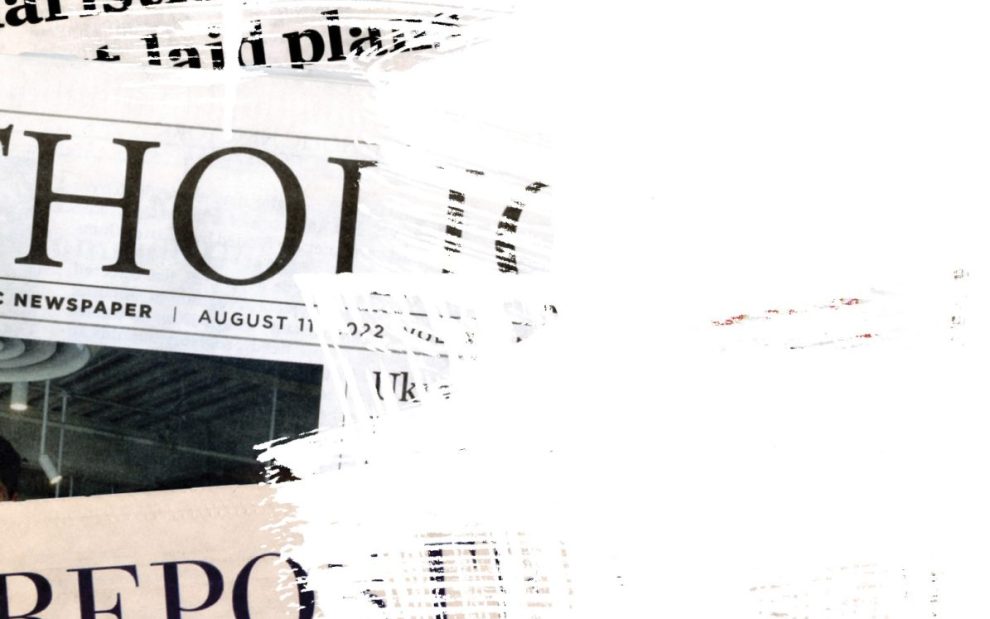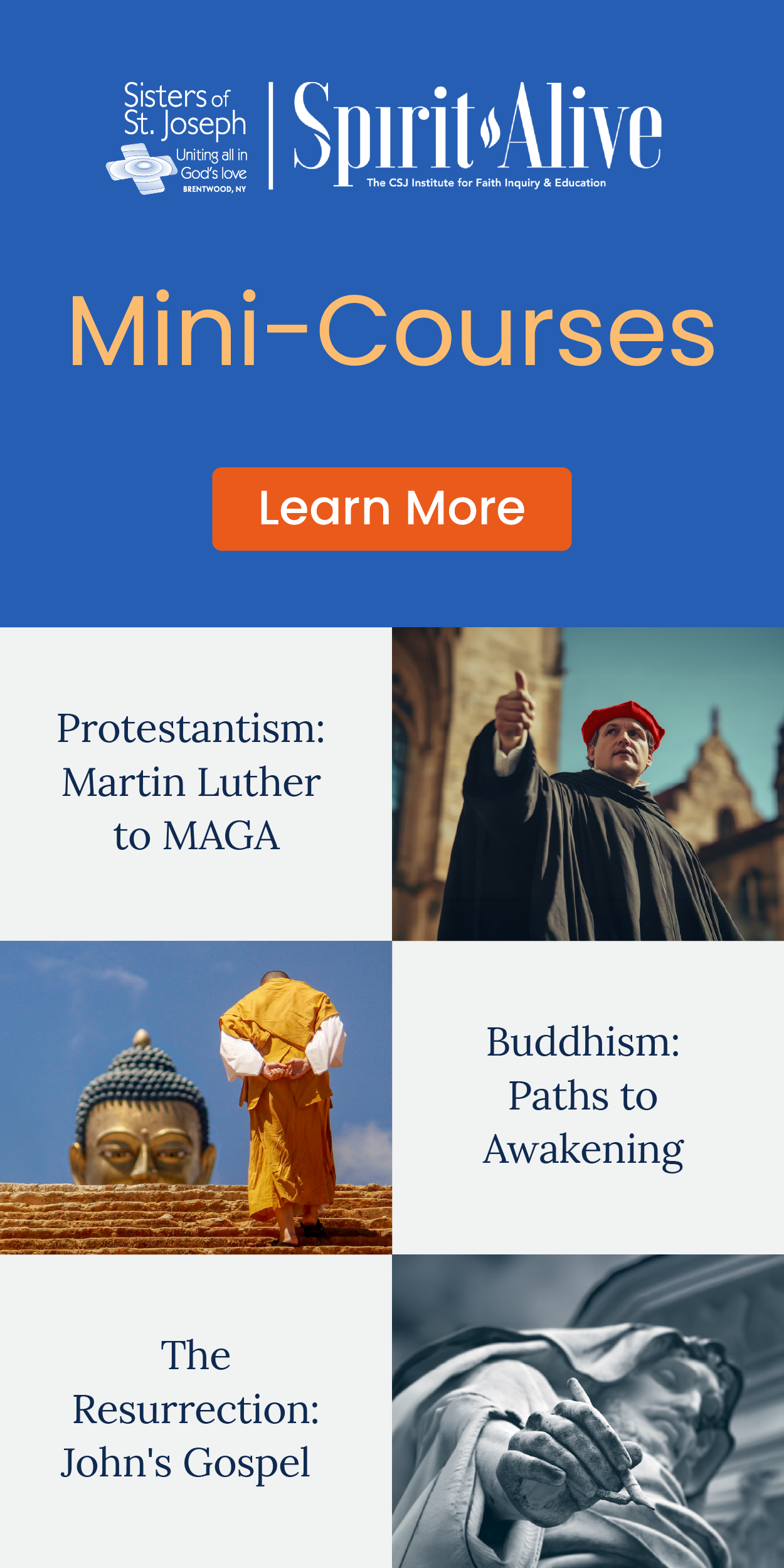There’s a story people like to tell about St. Óscar Romero’s media power: that you could walk anywhere in El Salvador on Sundays when he was archbishop without missing his homily, because it would be playing on the radio in every household and small business you passed. Mass communication was such an important part of his life that a typewriter, a tape recorder, and a microphone—the tools of journalism of his day—count among the saint’s second-class relics.
He used them to denounce, to explain, to document. As El Salvador headed into war in the late 1970s, sometimes he was the only one in the country broadcasting news of civilian killings and other aggressions. So, it was little surprise when in 2015, SIGNIS, the World Catholic Association for Communication, a global nonprofit for professionals in Catholic media, named Romero its patron saint.
Maybe it wasn’t the saint’s intention to practice journalism, but his focus— to document, to tell the truth—is at the heart of the profession and at the heart of Christianity’s mission of evangelization. That mission is increasingly threatened in the current landscape of Catholic media.
Facing shrinking budgets and rising publication costs, many bishops in the United States are dropping diocesan newspapers and other print products in favor of glossy monthly magazines, websites, and social media that communicate “positive public relations and entertainment,” says a January survey conducted by Canadian Catholic News with support from the U.S.-based Catholic Media Association.
The survey targeted editors at Catholic newspapers that had closed or transitioned to other formats between 2013 and 2023, a period that saw the demise of Catholic print publications in major U.S. cities such as New York, Detroit, and Seattle.
Surviving news organizations need to align themselves with the church’s “evangelization goals” if they want to continue, say respondents to the survey. But what bishops, journalists, and others in Catholic media see as evangelization varies, and some Catholics worry that focusing exclusively on positive developments not only misses journalism’s role in evangelization but also increases waning public trust in the church.
“I would side with those who say that evangelization, for a journalist, is telling the truth, and it is certainly not proselytizing (which Pope Francis rightly abhorred) and is also not the apologetics that is so popular today,” says David Gibson, director of the Center on Religion and Culture at Fordham University and an award-winning journalist, writer, and filmmaker. “Telling the truth is really the vocation of any Catholic, but the role of the Catholic journalist has the added responsibility of telling that truth in a way that communicates effectively, be it good news or bad news. The Catholic journalist has to convey the human experience to readers, and that means they must have certain skills and standards associated with a professional journalist.”
It’s obvious these days, however, says Franciscan Friar of the Atonement Father James Gardiner, that standards have shifted. While reading an online Catholic outlet recently that replaced one of his favorite diocesan newspapers, Gardiner, a former board member of the Religion Communicators Council, says he was disappointed to see “blaring favoritism there,” something a good Catholic journalist wouldn’t have condoned.
The shift that’s taking place raises questions about the balance between traditional journalism and the “new methods of communication” mentioned by editors who answered the survey. For some, the demise of Catholic newspapers also has come to mean the erosion of news and the rise of something different.
“Telling the truth is really the vocation of any Catholic, but the role of the Catholic journalist has the added responsibility of telling that truth in a way that communicates effectively, be it good news or bad news.”
–David Gibson
Carol Zimmermann, news editor for the National Catholic Reporter (NCR), says lately she has seen some stories in Catholic outlets post questions for readers to discuss at the end of an article. Sometimes, articles have included specific prayers for readers.
“I think Catholic readers get the connection of faith and action and don’t need to be hit over the head with it,” she says.
The nationwide closure of trusted Catholic outlets that spelled out the facts without a slant or opinion, serving solely as vehicles of information, has left a gap that’s plain to see, she adds.
“The magazines [that have replaced Catholic newspapers] tell stories of faith for certain, but not the nitty gritty daily living of faith or celebrations of faith on the parish level and also not the national perspective of how an act of Congress or a Supreme Court decision might impact people’s faith,” she says. “Both the local and national real-life perspectives are necessary.”
As a reporter for Catholic News Service (CNS), whose Washington offices the U.S. Conference of Catholic Bishops (USCCB) closed without explanation at the end of 2022, Zimmermann covered the Supreme Court. She wrote about the end of Roe v. Wade and interviewed those affected by the high court’s decisions on the death penalty, as well as a number of rulings on health care and education at Catholic institutions.
The stories she wrote appeared in a wide range of Catholic media outlets, from NCR, where she now works, to Our Sunday Visitor, which has, since 2023, been allowed by the USCCB to “acquire rights to the platform that CNS” used to produce and distribute its content.
For longtime consumers of Catholic news like Gardiner, who worked for decades in church communications in Washington and New York, that middle-of-the-road path is now hard to find, and the shift toward Catholic media becoming “house organs” is rapid and worrisome. It’s also frustrating as a reader, because it starts casting doubt on the role of the news organization, whether it’s there to provide the truth or carry out publicity, he says.
“[The role of Catholic media outlets] is not to be a lapdog. Their role is to tell the truth, nothing but the truth, even if it hurts,” he says.
Truth as the “good news”
Writing in 2021 about the role of evangelization and journalism for the French Catholic newspaper La Croix, Father William Grimm said that the “church desperately needs honest, objective, professional news sources or it will be useless for the proclamation of the Gospel.”
When church publications omit corruption and scandal in their midst, leaving the task to secular outlets, some people start seeing the church as an institution that values “cover-up over truth,” and some leave because of it, said Grimm, publisher of the Union of Catholic Asian News. But having the courage to tell the truth speaks volumes to others.
“Such honesty, while sometimes embarrassing, will also be confirmation to the world that we are committed to the truth and therefore worthy of some trust,” he wrote.
That’s why Catholic media has to “play it straight” when it comes to crime and scandal like the clergy sex abuse crisis, says Gibson, and even report on topics that some bishops find too controversial, such as covering LGBTQ+ Catholics.
As an avid reader of Catholic news, Gardiner says he sees less and less of that kind of approach in the church’s publications and finds himself more frequently turning to secular media for more holistic news about the church, even as some of those journalists struggle with interpreting faith aspects of current events, he says.
“They usurp the role, because no one else is doing it. They leave the church wide open,” he says.
Worse still, the public’s growing appetite for content they agree with could turn some Catholic outlets into partisan vehicles posing as faith publications, Gardiner says. And that’s something journalists shouldn’t be asked to do, according to Zimmermann.
“Just as journalists should not show a political bias, journalists for Catholic publications have the added responsibility of remaining neutral in coverage of the church—not leaning to a more liberal or conservative side but letting the facts or the responses and actions of church leaders and laypeople speak for themselves,” she says.
But that partisanship is exactly what is on the rise, says Gibson. Ideological or political actors with money have entered the cash-starved landscape, producing a “mixed bag” of Catholic outlets, he says, including some that have become microphones for the people or organizations that fund them, where opinions often pass as news.
“That means almost anyone with serviceable internet can log on and write something and call themselves a journalist. There is less connection to the church as a community and journalism as a profession,” he says. “In addition, many outlets are beholden to big donors whose identities may or may not be known. So, many outlets are writing to please a particular audience or donors rather than doing journalism or even evangelizing. It is reporting and writing to fit a preconceived agenda other than discovering the truth, wherever that may lead.”
That’s why the demise of CNS, which took the middle road, was devastating, Gibson adds, because it happened “just as social media and a few billionaire oligarchs were allowing or even pushing disinformation and misinformation.”
Change was coming
Matt Schiller, former advertising and business manager for Catholic New York, which closed in November 2022, says the changes that have taken place were inevitable and part of larger shift. Catholic publications are trying to reach out to a bigger audience beyond print, much in the same way secular outlets have been colonizing digital communication spaces for decades, he says.
“I think you have to keep evolving,” he says. “And you have to keep adapting.”
Secular news organizations, too, have downsized, moving print products online and sometimes closing as they dealt not only with declining revenues but also with a wave of public distrust of institutions, he says.
“Anything that’s news seems to be denigrated, which is a shame,” Schiller says. “News is vital. I mean, that’s how you plan. If you’re standing on the beach and there’s a news bulletin about a typhoon coming, you better know it, because otherwise it’s going to sweep you right off the beach. I think people just don’t see news that way.”
Schiller is a past president of the Catholic Press Association, the Catholic Media Association’s predecessor, which has now evolved to include non-journalists in its ranks. The Catholic Media Association, on its website, says that in the 1800s, Catholic newspapers, many of them produced by immigrant communities of faith such as the Irish, came into being as tools to clean up misinterpretations of Catholicism but also to defend communities from nativist views expressed in secular publications.
In 1911, the different publications banded together to form the Catholic Press Association as a way to “publicize news of Catholic interest” and combat the “negative influence of some of the secular press.” In 2020, its name changed to include diocesan communications staff and other nonpress members. On its website, the Catholic Media Association says that Catholic media “face the same challenges that existed nearly 200 years ago: explaining and defending the Catholic Church.”
“The church desperately needs honest, objective, professional news sources or it will be useless for the proclamation of the Gospel.”
–Father William Grimm
That has brought challenges, Schiller admits, particularly when you look at how outlets such as the Boston Globe reported on a grand scale about the clergy sex abuse crisis at the Archdiocese of Boston, while Catholic media didn’t have much “opportunity to respond or to tell the church’s side of it.” The independence to tackle those difficult topics has long been lacking, he says, and it’s not a new development.
“I don’t know that there’s much independence, but that’s true in a lot of media,” Schiller says.
Waning coffers, rising interest
Zimmermann says the only certainty for media these days, Catholic or otherwise, is that it’s in flux.
“The challenge is to stay afloat financially and find ways to reach a broader audience when so much competes for everyone’s time and energy,” she says.
Even as financial resources have become more scarce, Catholic appetite for information is on the rise, and faith readers show more trust in institutions.
A 2023 survey from the Center for Applied Research in the Apostolate (CARA) at Georgetown University found that 85 percent of Catholic adults “pay ‘a great deal’ or ‘some’ attention to national news.” It also showed that in the three months before being surveyed, “49% of respondents indicated they had read their diocesan newspaper or magazine,” which they trusted more than secular publications, the survey found. And CARA says that people who read “their diocesan newspaper or magazine have increased significantly since CARA’s 2011 and 2005 surveys.”
That interest, however, hasn’t translated into more resources for news at the diocesan level. Instead, some donors have put money behind fake Catholic newspapers such as the Catholic Tribune, which appears in swing states during election years, chasing votes and spreading disinformation among faith readers.
In some cases, that has resonated with readers who want to hear certain voices and not others, Schiller says.
“The producers of the content have also learned that people will absorb an awful lot and not test it for truth,” he says. “I fear that people only want to hear voices that agree with what they are saying. It’s so frightening to have that mentality.”
Schiller says he sees what is happening as a period of “pruning,” and, like it or not, it’s a time to become more efficient and get back to basics.
An uncertain future
It is easy to be discouraged, and optimism is probably not warranted for any traditional media organization, Catholic or otherwise, Gibson says, but there are positive developments.
“One is that as traditional media sheds talent, it increases the pool of professional journalists for Catholic media to draw on. Catholic media should be recruiting these pros,” Gibson says. “It is easier for trained journalists to come in and learn the Catholic beat than it is for a Catholic to come in and learn to be a professional journalist.”
Schiller says that modern communication products may not go away but instead change to slimmed-down versions of their predecessors, offering a balance of information and other content.
“What’s important is to keep getting out and keep trying things,” he says. “You can’t just lose hope. I think if there’s anything that we believe as Catholics, it’s that we believe in hope. You can’t let your story not be told.”
Gardiner worries that even if the publications survive, communication vehicles that credibly articulate the Catholic stance or the church’s teachings may already be compromised by a publicity-driven approach. If that happens, bishops will “pay for it later on,” and so will the church, he says.
“It’s very sad, I think,” Gardiner says. “The Catholic press is an ally for what the church wants to communicate. I fear for the Catholic press.”
“I fear that people only want to hear voices that agree with what they are saying. It’s so frightening to have that mentality.”
–Matt Schiller
The mission continues
Grimm points out that even in the early days of the church communication faced challenges, but its first evangelizer and communicator began a mission that continues.
“Two thousand years ago, when there was as yet no such thing as journalism, Jesus pointed out the hypocrisy of those who exercised power among and against believers. Today, that is part of the vocation of journalism,” Grimm wrote in La Croix. “If that doesn’t happen today, if the Church’s communications are just public relations, the Church and its mission suffer.”
Accidental Catholic journalist Romero believed in that mission. A 2015 NCR article called him “El Salvador’s most trusted news source,” because in a country where the rich controlled the media and ignored the reality of a descent into war, he was often the only one reporting murders, violations of human rights, and accounts of torture via his homilies, in articles he wrote for the diocesan newspaper, and through radio programs.
Because of this, militants bombed the radio station that broadcast Romero’s messages. But he always kept going. He was always looking for a way to put an antenna back together, fund his diocesan newspaper, and make time to meet with journalists from all over the world to get his message out any way he could.
Scrappiness has long been part of Catholic media’s DNA. Gibson says this trait could serve Catholic organizations well now, when secular organizations are eliminating religion beats and faith coverage due to their own struggling finances. Catholic organizations must step up to the plate, says Gibson, and take advantage of these opportunities.
Premier European Catholic publications such as Italy’s Avvenire and the French La Croix are exploring these opportunities says the Reuters Institute for the Study of Journalism in a June 2024 article. In an increasingly secular Europe, both these publications are pursuing non-Catholic audiences that have an interest in what the church has to say on immigration, climate change, poverty, and other social justice topics. In the United States, Catholics have made inroads with digital-only niche products, such as Black Catholic Messenger, founded by Nate Tinner-Williams.
“Catholic media have always operated on donations and grants and a shoestring. We are ahead of the game. There is less overhead and plenty of passion and dedication and opportunity to excel,” Gibson says. “That makes reliable Catholic journalists and outlets that much more important. But there are fewer of those, alas.”














Add comment